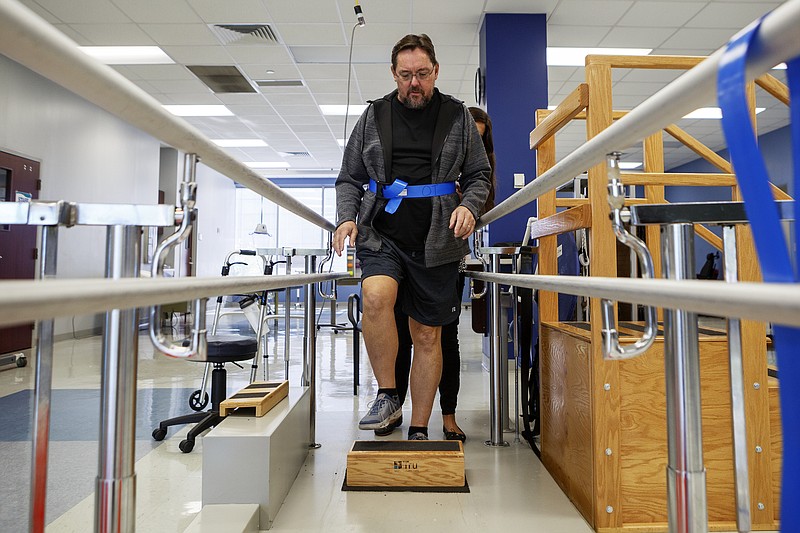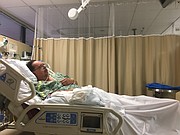Twenty-four hours after Kenny Fleshman thought he had food poisoning in August, he was unconscious and fighting for his life in the medical intensive care unit at Erlanger Health System.
He spent his 35th wedding anniversary in the hospital, but he doesn't remember.
"I remember being unloaded and after that [my memory] is all gone, for a week," Fleshman said.
There, he was diagnosed with eastern equine encephalitis virus - commonly called EEE or triple E - a rare cause of brain infections that can lead to death or lifelong neurologic problems. The virus is transmitted to humans through a mosquito bite. Typically, only a few cases are reported in the United States each year. Fleshman is the first case ever reported in Tennessee, according to a Tennessee Department of Health spokesperson.
And although he survived, which is better than about 30% of people infected with EEE, every aspect of his life is changed, he said.
On Friday, 61-year-old Fleshman announced his retirement after working for years as a real estate agent.
"I've got to decide how to use my resources, and chasing deals is just not what I want to do right now. I need to fix me," he said.
Physical tasks pose the greatest challenge, and cognitive ones aren't always easy.
His legs are shaky, and he's using a walker to get around, although doctors believe he can walk unassisted soon with continued therapy. His long-term memory is intact, but recent events are fuzzy. A game of Scrabble tires him to the point of needing a nap. Woodworking, one of his favorite pastimes, is too dangerous; he could easily lose a finger since his balance and fine motor skills are off. Before EEE, Fleshman built speakers for his beloved music room, but even his favorite tunes don't sound the same.
'It was like a bad horror movie'
Symptoms of EEE can include fever, headache, irritability, restlessness, drowsiness, anorexia, vomiting, diarrhea, blue skin, convulsions and coma, according to the U.S. Centers for Disease Control and Prevention.
Hours before Fleshman was taken to the hospital, he staggered to the bathroom, gripped the wall for balance and started seeing double. A little later, he started having body spasms. He sat in a bedroom chair to gather himself. Then his leg extended involuntarily and shook "so firm you could sit on it," he said. His wife called 911.
He had a full body spasm in the kitchen when the ambulance arrived. Although he was conscious, his body wouldn't cooperate. It took five people to get him on the gurney.
"It was like a bad horror movie," Fleshman said. "It was truly awful - frightening."
Knowing that something serious was wrong with his brain, Hamilton County EMS took Fleshman to the region's level-1 trauma center at Erlanger.
Once inside, Fleshman had a seizure, his fever reached 104 degrees and he was placed on a ventilator. He spent a week in the medical intensive care unit and two weeks on the hospital's third floor, surrounded by specialists and his family.
Doctors knew he had encephalitis - inflammation of the brain - and worked to rule out possible causes, including bacteria, fungus and autoimmune disorders. All signs pointed to a virus, but tests for West Nile and other viruses that can cause encephalitis and are more common locally all came back negative.
Dr. Abdelazim Sirelkhatim, a neurologist at Erlanger who treated Fleshman, said it's not possible or practical to test for every virus, and for most there are no treatments except for supportive care. High doses of intravenous steroids improved Fleshman's condition slightly, but he remained unconscious.
"It was a very, very difficult week," his wife, Diana Fleshman, said.
More Info
Several viruses, commonly referred to as arboviruses, circulate in mosquito populations and are transmitted when the mosquito feeds on humans and animals. West Nile Virus is the most common in Southeast Tennessee, but infections are generally much milder than EEE. Others such as chikungunya, Zika virus and dengue have been reported in the United States but are usually seen in returning travelers after visiting infected regions of the world.
To reduce mosquito exposure
Stay indoors if possible, especially during the dusk and dawn hours when mosquitoes are most active.If you go out during the dusk and dawn hours, wear light-colored, tightly woven, loose clothing and insect repellent.Wear enough insect repellent to cover skin and clothes that contain one of the following EPA-registered ingredients: DEET, Picaridin, Oil of Lemon Eucalyptus/PMD or IR3535.Keep window and door screens shut and in good condition. Repair holes.Eliminate breeding sites, such as containers that collect water, clogged drains and gutters, unused tires and overgrown brush.
Mosquitoes: more than a menace
EEE virus has circulated in the United States for decades, sporadically popping up in small pockets mostly in eastern or Gulf Coast states during late summer and early fall. This year, it's garnered national attention due to high-profile outbreaks in Massachusetts and Michigan, including several deaths.
The virus typically occurs at low levels in wild bird populations near low-lying, freshwater swamps. The birds themselves usually aren't sickened, and a species of mosquito that feeds almost exclusively on birds transmits it from one bird to another. However, excessive rainfall can cause more mosquitoes to breed and amplify the virus.
Medical and veterinary entomologist Gary Mullen, a professor emeritus at the Auburn University College of Agriculture, said when the presence of the virus builds up in the bird population, other mosquito species that are more general feeders are more likely to bite infected birds. Those mosquitoes are also more likely to bite other animals, which causes the disease to "spill over" to humans and horses.
"Most people don't really know this disease exists until we have an outbreak, and then it seems rare to that locality, but in the total scheme of things it could happen any year, any place where the conditions are right," Mullen said. "Horses are the ones that are most typically impacted - even more than humans - in terms of numbers of cases. But, it's very difficult to predict ahead of time where these things are going to occur."
There's no human vaccine against EEE, but there is a vaccine for horses. Mullen said although all horse owners in the United States should vaccinate their horses, many don't. The virus is almost always fatal in horses, so equine EEE deaths often serve as a warning sign that the virus is circulating and possible human infections will follow, he said.
"There are cases that occur every year in the U.S. of triple E in humans and horses, it's just they're not publicized until you get a death in humans or multiple cases in a particular area that draws more attention," Mullen said.
Sirelkhatim said it wasn't until Fleshman's family saw EEE in the news and told doctors that he recently attended a wedding near the gulf that they thought to test for the virus.
"We have to give credit," Sirelkhatim said. "We felt this is a very likely possibility, especially after reviewing the MRI and comparing it to some of the reported cases."
EEE attacks an area of the brain called the basal ganglia, which controls movement, and Sirelkhatim said most of Fleshman's inflammation was in that area. Erlanger sent the test to the CDC, which confirmed the diagnosis about a week later.
Fleshman said there's no way to know for sure where he was bitten, but officials speculate it was somewhere between Pensacola, Florida, and Gulf Shores, Alabama, or along his trek home to Soddy-Daisy, Tennessee.
"By the time it manifests, there's no bite left on you but the incubation period seems to line up," Fleshman said.
Making strides
Fleshman spent three weeks at Erlanger before being transferred to Siskin Hospital for Physical Rehabilitation, where he stayed for almost a month. He returned home on Oct. 2, and completed his second outpatient therapy session at Siskin's Center for NeuroRecovery on Friday.
Fleshman attributes his survival to a quick response from his wife, Hamilton County EMS and his medical care teams at Siskin and Erlanger. Sirelkhatim said critical care, neurology, infectious disease, internal medicine and the nursing staff at Erlanger all contributed to the case.
He's taking anti-seizure meds and drugs used to treat "Parkinsonism" - tremors, slow movement, impaired speech or muscle stiffness resembling Parkinson's disease - that Fleshman has as a result of his infection. He also got new glasses to help with his double vision.
Rebecca Weant, his physical therapist at Siskin, said the main things are for him to build strength and balance.
"He has a more shuffled gate, so we're working on increasing stride length, step height," Weant said. "He's using a walker right now, which I think he definitely can get away from, so I'm not letting him use it as much during therapy. Building his confidence is really important."
He avoided them for awhile, but he finally looked at the photos of himself in the hospital.
"It's mostly terrible from my perspective, because I'm thinking, 'My kids are standing there looking at me,'" he said.
Fleshman said it's hard to process and relate to almost dying. His primary care doctor said it's important to take care of his mental health.
"I think that may be just as important as the rest of it," Fleshman said. But he didn't believe he'd make it as far as he already has and is improving.
He wants the public to know that this virus exists, the symptoms and know to go to the right hospital, because it's a disease that the local doc at a small hospital probably won't recognize.
"I don't think it's an epidemic, but there's probably a lot more people that have died from this than they know," he said.
Last week, Fleshman navigated with his walker through his music room, showing off some of his speakers. He hopes his tremors will stop so he can get back in the shop one day and start building again.
"These are the best ones I've done yet," he said, motioning to a three-tiered wooden speaker that resembles a vintage one from the 1930s. Its required him to bend plywood and make complicated cuts to create curves.
Diana called him "a renaissance man." She said she hopes his brain will allow him to do the things he used to. He enjoys reading, is a great writer, loves music, but "he's not as passionate about those things right now, it's almost like he's lost that passion for them or something, and I hope that comes back," she said.
He sold his truck since he can't drive now.
"We won't be rich, but we can live here happily ever after, I think," he said. "My retirement plan was to build things, because I enjoy it. It's a lot of fun."
"Maybe you can again," Diana Fleshman said.
"Maybe I can," he said. "Just not this week."
Contact Elizabeth Fite at efite@timesfreepress.com or 423-757-6673.

